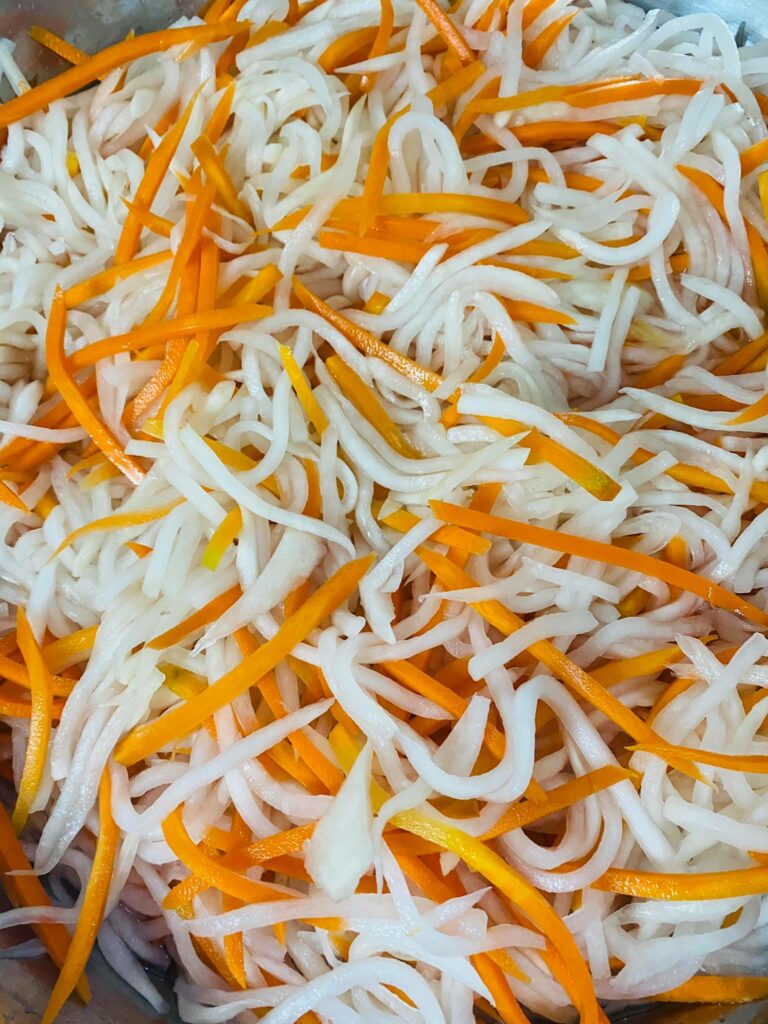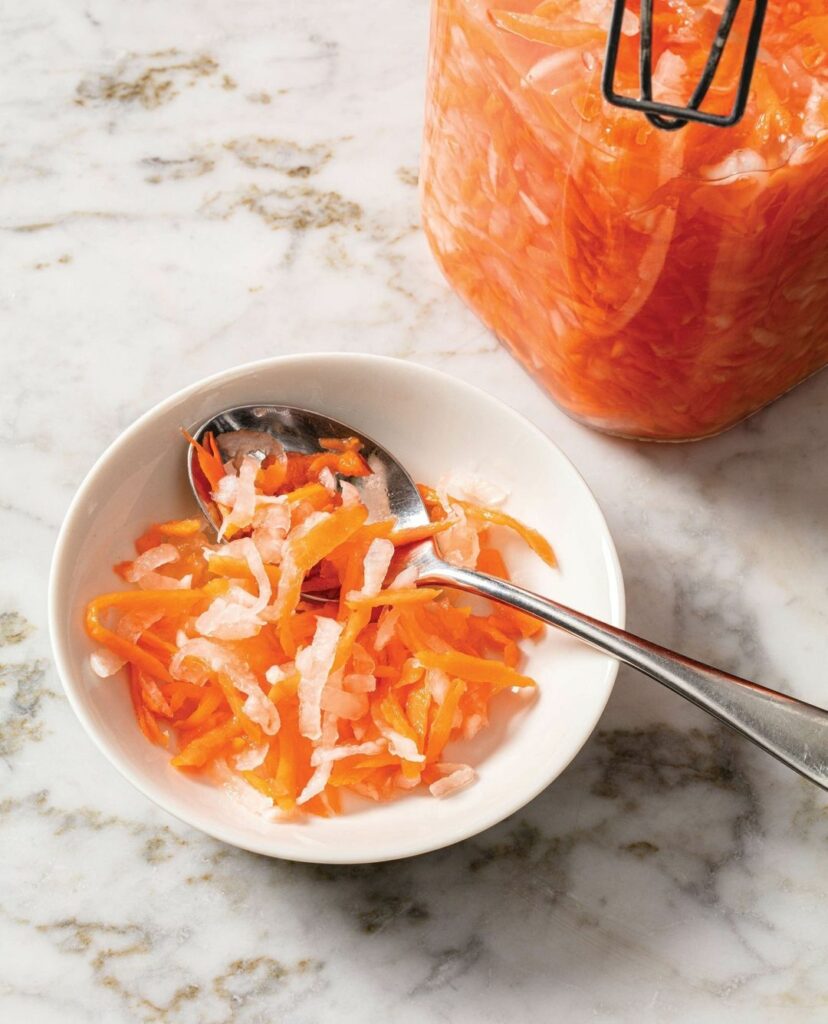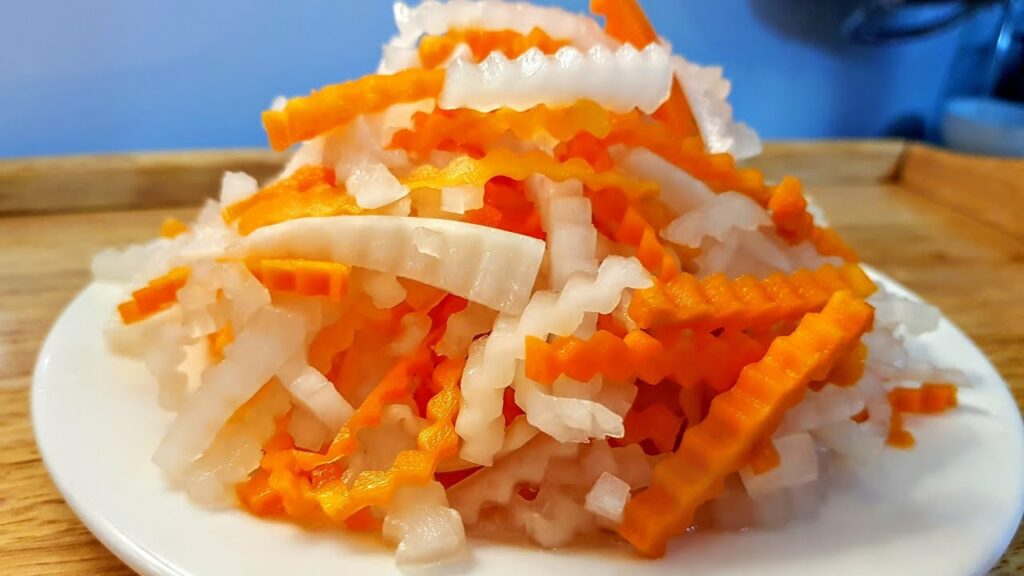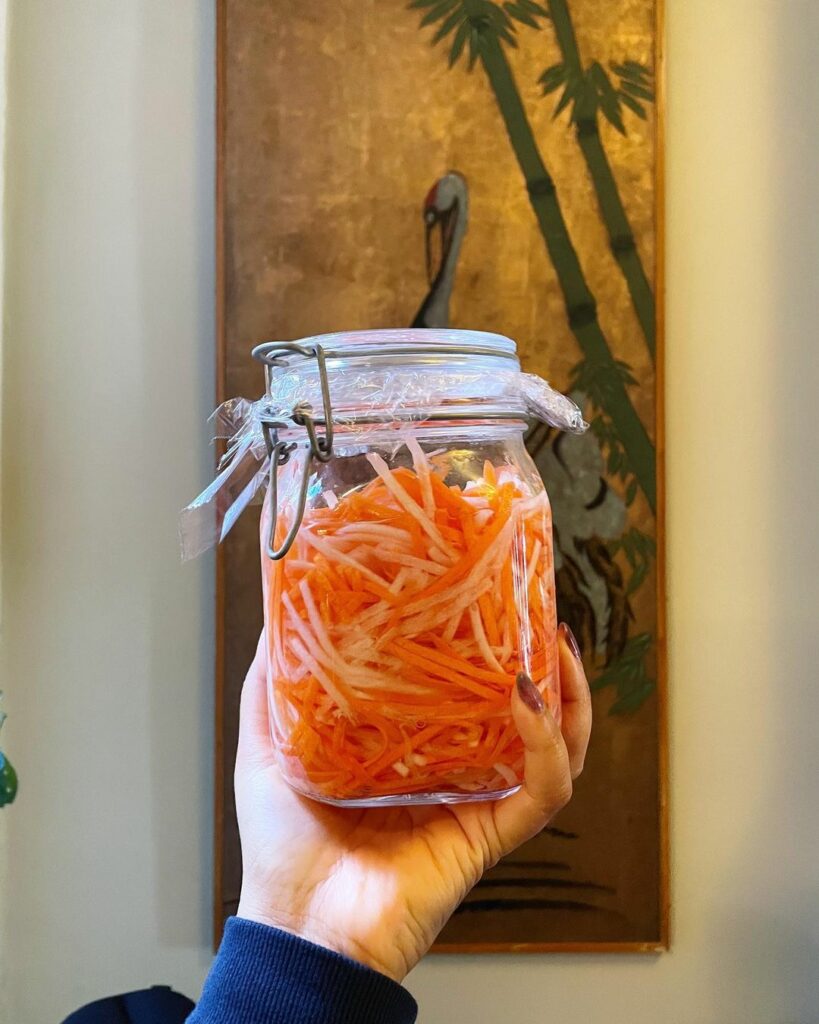As someone who loves exploring different cuisines, I was excited to try banh mi during a trip to Vietnam. The crusty baguette and flavorful fillings made it an instant favorite. But it wasn’t until I tried pickled banh mi that I truly fell in love.
The tangy, crunchy pickled vegetables added a whole new dimension of flavor and texture to the sandwich. It was like nothing I had ever tasted before. Since then, I’ve been on a mission to recreate that perfect pickled banh mi at home.
In this article, I’ll share everything I’ve learned about this delicious Vietnamese dish, from its history to its health benefits and, of course, how to make it yourself. Whether you’re a banh mi enthusiast or a curious foodie, I hope this guide will inspire you to try pickled Vietnamese vegetables for yourself.
What is pickled banh mi?

Pickled banh mi is a type of Vietnamese sandwich that features a combination of crusty bread, savory proteins, fresh herbs, and pickled banh mi. The pickled banh mi, typically carrots, daikon radish, and cucumber, are marinated in a mixture of vinegar, sugar, and salt, which gives them a tangy and slightly sweet flavor. This delicious sandwich is a popular choice for Vietnamese breakfast, offering a refreshing and satisfying start to the day. Vietnamese breakfast enthusiasts often seek out pickled banh mi as a flavorful and convenient option to kick off their mornings.
Historically, banh mi was a product of French colonialism in Vietnam during the 19th century. The French introduced the baguette to Vietnam, and locals started to incorporate traditional Vietnamese ingredients, such as grilled meats, pickled banh mi, and herbs, into the sandwich. Over time, banh mi became popular street food across Vietnam and eventually spread to other parts of the world.
The pickling of vegetables was likely a practical way to preserve them for longer periods and added a refreshing, tangy flavor to the sandwich. Today, pickled banh mi is a beloved dish that is enjoyed by people around the globe for its unique combination of flavors and textures.
Must read: Banh Mi Pate: A French-Vietnamese Delight
Pickled banh mi recipe

This pickled Vietnamese vegetables can be made in advance and stored in the refrigerator for up to two weeks. Here is a recipe for pickled banh mi commonly used in banh mi:
Cooking note:
- Yield: 4
- Prep time: 30 minutes
- Cook time: N/A
- Total time: 30 minutes
- Course: Condiment
- Cuisine: Vietnamese
Equipment:
- Large bowl
- Colander
- Glass jar or container with a lid
Ingredients:
- 2 medium carrots, julienned
- 1 small daikon radish, julienned
- 1 small cucumber, julienned
- 1/2 cup rice vinegar
- 1/4 cup sugar
- 1/4 cup water
- 1 teaspoon salt
Table nutrient facts of pickled banh mi
Here is a table of nutrient facts for pickled Vietnamese vegetables commonly used in banh mi (based on a serving size of 1/4 cup):
| Nutrient | Amount |
| Calories | 17 |
| Sodium | 240 mg |
| Total Carbohydrates | 4g |
| Dietary Fiber | 1g |
| Sugars | 3g |
| Vitamin C | 9% DV |
| Vitamin K | 6% DV |
| Calcium | 1% DV |
| Iron | 1% DV |
These pickled banh mi are low in calories and fat and are a good source of fiber and vitamin C. They are also relatively high in sodium, so it’s important to consume them in moderation if you are watching your sodium intake. Pickled banh mi are a healthy and flavorful addition to banh mi and other dishes
How to make pickled banh mi, step-by-step?

Here’s how to make pickled Vietnamese carrots step-by-step:
- Peel and cut the carrots into matchsticks or thin slices. You can use a mandoline or a sharp knife for this.
- Place the carrot sticks or slices in a glass jar or airtight container.
- In a separate bowl, whisk together the white vinegar, water, sugar, and salt until the sugar and salt are dissolved.
- Pour the vinegar mixture over the carrots in the jar or container, making sure that the carrots are fully covered by the liquid.
- Close the jar or container and let it sit at room temperature for at least 1 hour.
- After 1 hour, transfer the jar or container to the refrigerator and let it pickle for at least 24 hours or up to a week.
- To use the pickled Vietnamese carrots in banh mi or other dishes, simply remove them from the pickling liquid and drain off any excess liquid.
These pickled Vietnamese carrots can be stored in the refrigerator for up to a week. They add a tangy and slightly sweet flavor to banh mi and are a great addition to other Vietnamese or Asian-inspired dishes.
Different types of vegetables for pickling
Here are different types of vegetables for pickling and tips and tricks for perfectly pickled banh mi, with a focus on the best pickled vegetables for banh mi:
- Carrots: Carrots are a popular choice for pickling and are commonly used in banh mi. They are firm and hold their shape well, making them a great option for slicing or julienning.
- Daikon radish: Daikon radish is another common-pickled banh mi used in banh mi. It has a mild and slightly sweet flavor and adds a nice crunch to the sandwich.
- Cucumbers: Cucumbers are a refreshing and juicy addition to pickled Vietnamese vegetables. They are also a great option for those who prefer a milder flavor.
- Red onions: Red onions are a popular pickling option for their vibrant color and slightly sweet flavor. They are great for adding some zing to banh mi.
- Jalapenos: For those who like a bit of heat, jalapenos are a great option for pickling. They add a spicy kick to banh mi.
Tips and tricks for perfectly pickled banh mi
- Use fresh vegetables: The quality of your vegetables is crucial for achieving the best pickling results. Use fresh and crisp vegetables for the best flavor and texture.
- Slice or julienne vegetables thinly: Thinner vegetables will pickle faster and absorb more flavor.
- Use a pickling liquid with the right balance of acidity, sweetness, and saltiness: A good pickling liquid should have a balance of these three elements to achieve the best flavor.
- Use a glass jar or container with a tight-fitting lid: Airtight containers are important for preserving the freshness and flavor of pickled Vietnamese vegetables
- Let the vegetables sit in the pickling liquid for at least 24 hours: The longer the vegetables sit in the pickling liquid, the more flavorful and tender they will become.
With these tips and tricks, you can achieve perfectly pickled banh mi that will add a delicious and tangy flavor to your banh mi.
What are serves suggestions for pickled banh mi?
Pickled banh mi can be used in a variety of dishes, and here are some serving suggestions:
- Banh mi: Pickled Vietnamese vegetables are a key component of banh mi and adds a tangy and refreshing flavor to the sandwich. Layer them onto your favorite banh mi recipe for a delicious and satisfying meal.
- Rice bowls: Add a scoop of pickled banh mi to your rice bowl for a burst of tangy flavor and crunch. This is a great option for a healthy and satisfying meal.
- Tacos: Pickled banh mi is a great addition to tacos, adding a tangy and crunchy texture that pairs well with spicy meats or beans.
- Sandwiches: Add pickled banh mi to any sandwich for a tangy and refreshing flavor. They work especially well with grilled meats or vegetables.
- Salads: Pickled banh mi can be a great addition to salads, adding a tangy and flavorful element to the dish.
- Snacks: Pickled banh mi can also be enjoyed on their own as a quick and healthy snack. Simply take a few bites of the pickled banh mi straight from the jar for a refreshing and flavorful snack.
Pickled Vietnamese vegetables are a versatile ingredients that can be used in many different ways to add flavor and texture to a variety of dishes. Try them in any of the above-serving suggestions, or get creative and come up with your own unique way to enjoy them!
Try this: The Ultimate Recipe for Meatball Banh Mi: Perfect for Any Occasion
What are variations of pickled banh mi?

There are many variations of pickled banh mi that you can make, depending on your personal taste and the ingredients you have on hand. Here are some popular variations:
- Pickled jalapenos: If you like a bit of spice, pickled jalapenos are a great option. Simply slice jalapenos into rounds and pickle them in a mixture of vinegar, water, sugar, and salt.
- Pickled red onions: Pickled red onions add a vibrant color and a slightly sweet flavor to dishes. Slice red onions thinly and pickle them in a mixture of vinegar, water, sugar, and salt.
- Pickled green beans: Pickled green beans make a great snack or addition to salads. Blanch the green beans for a minute, then pickle them in a mixture of vinegar, water, sugar, and salt.
- Pickled beets: Pickled beets are a delicious and colorful addition to salads or sandwiches. Simply slice cooked beets thinly and pickle them in a mixture of vinegar, water, sugar, and salt.
- Pickled cauliflower: Pickled cauliflower is a tasty and crunchy addition to dishes. Break the cauliflower into small florets and pickle them in a mixture of vinegar, water, sugar, and salt.
- Pickled radishes: Pickled radishes are a tangy and refreshing addition to salads or sandwiches. Slice radishes thinly and pickle them in a mixture of vinegar, water, sugar, and salt.
Many different vegetables can be pickled and many different flavor combinations to try. Get creative and experiment with different types of vegetables and pickling liquids to find your favorite variation.
Substitute ingredients of pickled banh mi
If you’re looking to make pickled Vietnamese vegetables but don’t have all the necessary ingredients, or if you want to try a different flavor profile, there are several substitute ingredients that you can use. Here are some examples:
- Vinegar: If you don’t have white vinegar, you can use other types of vinegar such as apple cider vinegar, rice vinegar, or red wine vinegar. Just keep in mind that different types of vinegar will result in slightly different flavors.
- Sugar: If you want to reduce the amount of sugar in your pickling liquid, you can substitute it with honey, agave nectar, or maple syrup. Just note that these substitutions will also add their own unique flavors to the pickled banh mi.
- Salt: If you’re watching your sodium intake, you can reduce the amount of salt in your pickling liquid or use a salt substitute such as potassium chloride. Just keep in mind that the flavor may be slightly different.
- Vegetables: If you don’t have the specific vegetables called for in a recipe, you can substitute them with other vegetables that pickle well, such as bell peppers, green beans, or cabbage. Just keep in mind that different vegetables will have different textures and flavors when pickled.
- Spices: You can also experiment with different spices and herbs to add flavor to your pickled banh mi. Try adding garlic, ginger, peppercorns, or fresh herbs like dill or cilantro.
Pickled banh mi is very forgiving, and you can experiment with different ingredients and flavors to find what works best for you. Just be mindful of the ratios of vinegar, sugar, and salt, as well as the pickling time, to ensure that the pickled banh mi turn out well.Ready-made pickled vegetables are widely available and can be found at many different types of retailers. Look for them in your local grocery stores and specialty food stores, or consider purchasing them online for convenience.
Also read: Are White Vinegar vs White Wine Vinegar Effective?
How to store pickled banh mi?
In addition to teaching you how to store pickled banh mi, I’ll give you some tips on how to properly store pickled banh mi and be able to enjoy your pickled banh mi if you don’t eat it all.
Storing pickled banh mi
- Pickled banh mi can be stored in the refrigerator for up to 3 days.
- Store it in an airtight container to prevent moisture from getting in.
- Keep the pickled vegetables separate from the bread and protein until ready to eat to prevent the bread from becoming soggy.
When pickles go bad
- Pickled banh mi can go bad if they are not stored properly or is left out at room temperature for too long.
- Signs that pickles have gone bad include a mushy texture, a sour or off-putting smell, or a cloudy appearance.
- If you suspect that when pickles go bad, it’s best to err on the side of caution and throw them out.
Reheating pickled banh mi
- Pickled banh mi should not be reheated, as the pickled vegetables will lose their crispness and texture.
- If you prefer a warm banh mi, consider grilling or toasting the bread and protein before assembling the sandwich.
Freezing pickled banh mi
- Pickled banh mi is not a good candidate for freezing, as the pickled vegetables will become mushy and lose their flavor and texture.
- It’s best to enjoy pickled banh mi fresh or store it in the refrigerator for up to 3 days.
Tips for making pickled banh mi
If you’re looking for tips on how to pickled banh mi, here are a few suggestions:
- Choose the right vegetables: The traditional pickled vegetables used in banh mi are carrots and daikon radish. Make sure you choose fresh, firm vegetables that are free from any blemishes or soft spots.
- Slice the vegetables thinly: The key to great pickled vegetables is to slice them thinly, so they absorb the pickling liquid and develop a tangy flavor. You can use a mandoline or a sharp knife to slice the vegetables into thin matchsticks.
- Make the pickling liquid: To make the pickling liquid, combine vinegar, sugar, salt, and water in a saucepan and heat until the sugar dissolves. You can add other flavorings like garlic, ginger, or chili peppers to the liquid if you like.
- Combine the vegetables and pickling liquid: Once the pickling liquid has cooled, pour it over the sliced vegetables in a jar or container. Make sure the vegetables are completely submerged in the liquid. You can also add additional spices or herbs like cilantro, mint, or basil to the pickling jar.
- Let it pickle: Let the vegetables sit in the pickling liquid for at least an hour, but preferably overnight, in the refrigerator. This will allow the flavors to develop and the vegetables to become tangy and crisp.
- Drain before using: When you’re ready to use the pickled vegetables, drain them well and pat them dry with a paper towel. They’re now ready to use in your banh mi sandwich!
You’ll be able to create delicious and tangy pickled vegetables that will take your banh mi sandwich to the next level.
See more: How to Make Roasted Pork Belly Banh Mi at Home?
FAQs
Is pickle a healthy snack?
Pickles can be a healthy snack, as they are low in calories and fat and are a good source of vitamins and minerals. However, pickles are also high in sodium, so it’s important to consume them in moderation if you are watching your sodium intake.
Can I eat pickles for weight loss?
Pickles can be a good snack option for weight loss, as they are low in calories and fat and can help you feel full due to their high water content. However, it’s important to choose pickles that are low in sodium and to consume them in moderation as part of a balanced diet.
Can I make pickled banh mi ahead of time?
Pickled banh mi can be made ahead of time and stored in the refrigerator for up to 3 days. In addition, pickled banh mi is not recommended for freezing, as the pickled vegetables will become mushy and lose their flavor and texture.
However, it’s best to keep the pickled vegetables separate from the bread and protein until ready to eat to prevent the bread from becoming soggy.
Conclusion
Finally, pickled banh mi is a versatile and flavorful ingredient that can be enjoyed in a variety of dishes. Pickling is a simple process that involves immersing vegetables in a vinegar-based solution, which adds tanginess and crunch to the vegetables. When making pickled banh mi, it’s important to choose fresh vegetables and to use a pickling liquid with the right balance of acidity, sweetness, and saltiness. Airtight containers are also important for preserving the freshness and flavor of pickled vegetables. In summary, pickled banh mi is a delicious and healthy ingredient that can add flavor and texture to a variety of dishes. Experiment with different types of vegetables and pickling liquids to find your favorite variation, and enjoy pickled vegetables as a tasty and nutritious addition to your meals.